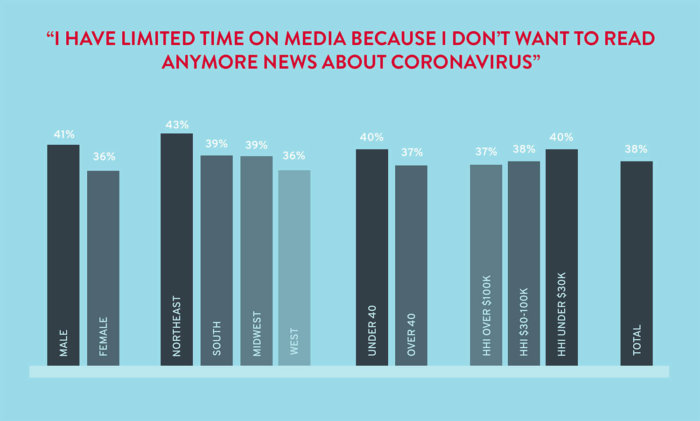Brands Should Pivot to Avoid Consumers’ COVID Fatigue
What’s happening?
New data from MindShare’s US Consumer Tracking Study shows the first signs of COVID-19 consumer burnout. Five weeks into the pandemic, the percentage of Americans who are aware of brands helping with the crisis has fallen sharply – to less than 50% – after four weeks of steady increases.

At the same time, the MindShare study reports that media consumption around COVID-19 content has also begun to decline, with the majority of American’s spending less time reading, listening or watching media specifically for COVID-19 information. In fact, many people are actively limiting the amount of time spent with COVID-19 information, with the highest avoidance rate among males under the age of 40 in the hard-hit Northeast.

What does this mean?
Consumers are beginning to show the signs of COVID-19 burnout as the pandemic itself has created considerable anxiety, stress and uncertainty for everyone. This new research – and data from other sources including Russell Research and the New York Times – point to Americans wanting a way forward, not to be reminded of where we have been or where we are currently: quarantined in our homes trying to flatten the curve.
What should marketers be doing?
Throughout the duration of the pandemic, the impacts on consumers and therefore their mindsets and attitudes will continue to shift. Marketers should remain flexible with their messaging to ensure it continues to resonate. Given the most recent shifts in consumer sentiment, brands should consider the following:
- The time for the generic “we’re here for you” or “we’re in it with you” is over. When the pandemic first started, many brands did a great job of creating empathetic messaging that showed consumer understanding and provided comfort and confidence. But consumers have been inundated with those messages, and are either becoming immune or actively turned off by them.
- Focus on how your brand can help us move forward. While consumers are tired of COVID-19 news, they still want to hear from brands who are finding new ways to help or thinking about what comes next. Make sure your brand is focusing on finding solutions, not just reiterating the problems.
- Make sure your content is ownable and relevant to your brand. Just because there is likely to be a sustained shift toward working from home doesn’t mean every brand should share “tips on how to work from home.” Authenticity is key: if the content isn’t relevant to your brand – or is already being communicated by dozens of others – don’t use it.
- Keep your tone positive. Consumers are still inundated with negative emotions, so even if your messaging has nothing to do with COVID-19, make sure the tone is positive and optimistic. This is not time to use scare tactics or dwell on the negative – we already have enough of that.
As you work to remain flexible in your messaging approach, are you clear on when and how to bend? We can help.

